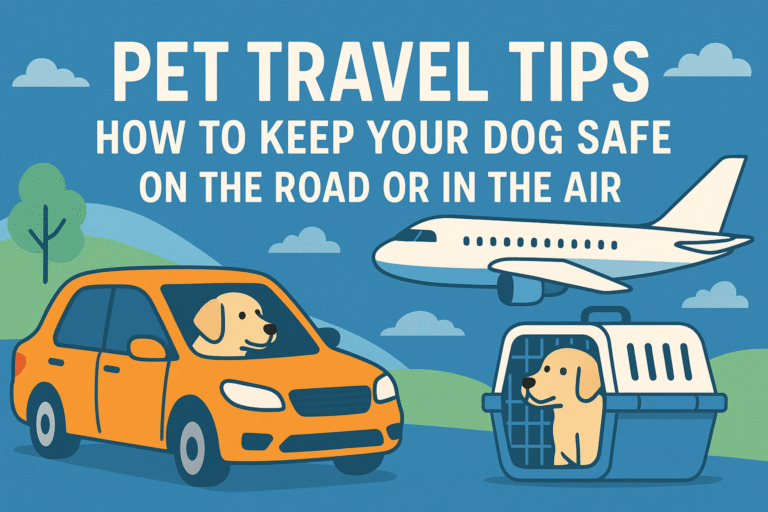Effective Dog Training Techniques You Can Use at Home
Training your dog at home isn’t just about learning tricks—it’s a way to build trust, correct behavior, and deepen your connection with your pet. With the right methods, you can achieve long-term results without spending a fortune on classes. Let’s look at proven, humane, and well-tested methods you can use today.
Why Home Training Matters
Home training provides a relaxed environment where your dog is relaxed and safe. It is here that they will best be able to focus and learn. Furthermore, frequent practice makes the interaction you have with your dog better, leading to better behavior in the home and outside the home.
1. Positive Reinforcement: Reward Good Behavior
Positive reinforcement is perhaps the most powerful training method. As your dog does a good deed, reward them immediately with treats, praise, or playtime. This makes your dog connect good things with positive consequences.
How to use it in your own home:
- Utilize tiny, delicious treats for instant rewards.
- Combine rewards with verbal reinforcement such as “Good job!”
- Phase out rewards gradually as behaviors settle into routines.
2. Clicker Training for Accuracy
Clicker training employs a small device that produces a clear “click” to mark good behavior, and then a reward follows. The click alerts your dog specifically what they’ve done correctly.
Instructions to begin:
- Charge the clicker: click and reward until your dog is relating the sound to rewards.
- Reward every click with a treat or toy.
3. Clear Commands
Consistency is paramount. Use the same tone and words to say “sit,” “stay,” and “come” every time. Don’t use two words to do something because your dog will become mixed up.
Pro Tip: Practice commands in multiple rooms to enable your dog to generalize the behavior.
4. Crate Training for Structure and Safety

A crate is not punishment—it’s a sanctuary for your dog. Proper crate training can housebreak and cure separation anxiety.
Success rules
- Introduce the crate gradually with treats and toys.
- Don’t use the crate to discipline.
- Crate time should be comfortable and enjoyable.
5. Leash Training for Improved Walks
Leash pulling is unavoidable but can be managed. Teach your dog to walk well by stopping every time they pull on the leash and rewarding them for walking quietly at your side.
Practice this ability:
- Use a short leash for better control.
- Always turn around to keep your dog interested.
- Reward quiet walking with praise or treats.
6. Socialization at Home
Expose them to new sights, new sounds, and new experiences to thoroughly socialize them. You can start at home by exposing them to different household noises, different people, and safe items.
Socialization ideas:
- Play city noise or firework noises at low levels.
- Host friends over to socialize your dog.
- Add new textures like rugs or mats for them to walk on.
7. Establishing Boundaries and Household Rules
Your dog likes predictability. Choose early on what they can and cannot do and what is considered good behavior. Be consistent so that they know what to expect.
Sample rules:
- No jumping on the couch except when invited in.
- Wait at the door before going out.
- Eat only out of their own bowl.
8. Redirecting Bad Behavior

Replace bad with good. If your dog is shoe-chewing, provide chew toys. IIf your dog barks too much, focus on teaching the “quiet” cue.
Why it works: Dogs are more responsive to direction than to punishment, resulting in faster and longer-term results.
9. Short, Routine Training Sessions
Dogs have shorter attention spans and learn in 5-10 minute chunks, repeated throughout the day. Extended training sessions beget frustration and boredom.
Schedule idea
- Morning: simple commands.
- Afternoon: practicing walking on a leash.
- Evening: mental game stimulation.
10. Mental Stimulation and Enrichment
Boredom can cause destructive behavior. Provide puzzles, treat-dispensing toys, and scent games to challenge your dog.
Easy enrichment ideas:
- Place treats around the house to create a fun “treasure hunt” for your dog.
- Find new tricks like “spin” or “shake.”
- Rotate toys weekly so they remain new.
Mistakes to Avoid
- Consistency: Issuing different commands for the same behavior confuses your dog.
- Harsh punishment: It kills confidence and can result in fear-based behavior.
- Paying for instant outcomes: Training is time- and patience-intensive.
FAQs On Dog Training Methods You Can Implement at Home
- How do I train a dog at home?
Depends on age and temperament. Most dogs get better in 2-4 weeks with regular training. - What are the best treats to use for training?
Small, tender treats are ideal since they’re easy for your dog to eat and provide strong motivation during training. - Can you train an older dog?
Yes! Old dogs can learn new tricks with the same good methods, but be careful. - How much do I train my dog?
2-3 short training sessions daily will solidify learning without filling up your dog. - What should I do if my dog isn’t motivated by food rewards?
Use play, toys, or verbal reward rather than treats. - Do I employ a professional trainer if at-home techniques fail?
If you are stuck, you can seek professional advice and troubleshoot with a professional trainer.
Conclusion: Building A Deeper Bond Through Training
Effective home dog training is not just obedience—it forges trust, creates order, and builds a better relationship with you and your dog. By patiently, consistenly, and effectively applying the right techniques, you’ll set the stage for a happier, better-behaved companion.







